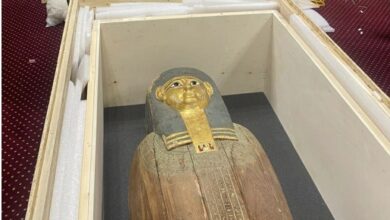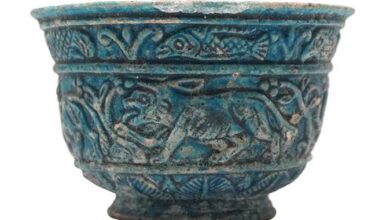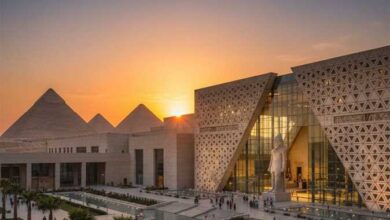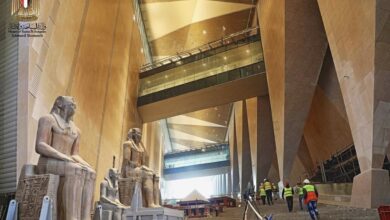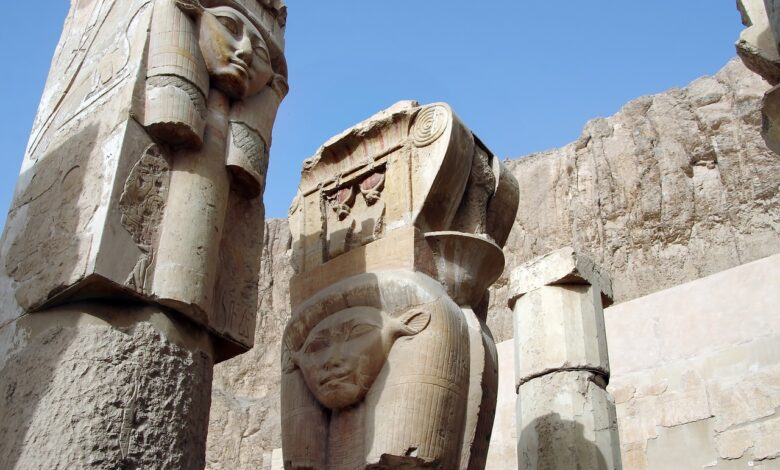
We are still discussing the many archaeological discoveries we announced back in January 8, revealed by the Egyptian mission I headed in front of one of the most beautiful pharaonic temples in Egypt – the funerary temple of Queen Hatshepsut, known as Deir el-Bahari on the west bank of Luxor.
Previously, we talked about the artifacts uncovered dating back to the era of King Ahmose I, the expeller of the Hyksos, the grandfather of Queen Hatshepsut, as well as the remains of the Valley Temple and the causeway.
The excavations revealed the existence of a huge cemetery dating back to the Ptolemaic era, which began after the death of Alexander the Great and the assumption of power by one of his army leaders – Ptolemy I – who ruled Egypt, founding what is known as the ruling Ptolemaic dynasty in 305 BC.
It ended with the death or suicide of its most famous kings, Queen Cleopatra, and the transformation of Egypt into a part of the Roman Empire in 30AD.
What we have uncovered is part of a vast Ptolemaic cemetery in the area known as Asasif.
There, we have uncovered tombs built entirely of mud bricks, consisting of chambers and halls that rise above the ground surface, while the burial chambers are accessed through shafts dug into the rock.
The upper chambers and halls were designed for the family of the deceased to gather, offer sacrifices, and perform funeral service rituals for the deceased.
Another type of tomb was also discovered, consisting of burial chambers built of mud bricks with gabled roofs that can accommodate more than one individual, with a burial shaft that reaches to its entrance and continues to descend until it reaches another burial chamber carved entirely into the natural rock of the mountain.
These tombs have chapels and chambers above ground for performing funeral service rituals for the dead buried in these tombs, which are called ‘family tombs’.
A large number of poor surface burials have been uncovered, which can accommodate only one deceased, be they a man, woman, or child. In general, no significant artifacts were found inside these burials except for some pottery vessels.
Many important artifacts were discovered within the large family tombs, including bronze coins with the image of Alexander the Great on one side and the name of Ptolemy I on the other.
Among the discovered artifacts are a large number of terracotta statues, i.e., made of pottery, depicting animals, birds, and human figures with strange faces. These statues are dolls that were buried with dead children.
One of the most beautiful discoveries is a pottery vessel for the god Bes, as well as a number of pottery vessels designated for cosmetics.
The bodies that were discovered were not mummified in the conventional sense. They were instead dried with natron salt and wrapped well with linen bandages.
The mummies of the wealthier classes meanwhile were covered with what is known as cartonnage, which is thick layers of linen covered with gypsum, with colorful drawings in bright colors that depict chapters from the Book of the Dead and books of the other world.
These include scenes of sacrifices and depictions of the four sons of Horus offering linen to mummify the body of the deceased, as well as scenes of the trial of the deceased in the courtroom in the other world.
The bottom line is that what we have uncovered in the cemetery, which dates back to the Ptolemaic era, are the tombs of those who were born, lived, and died in Egypt during that era, and their religion and customs were purely Egyptian.
The excavation work also revealed a large number of secrets from the era when Egypt was ruled by foreign kings from Alexandria. These include tombs that were built at the lowest cost, even those whose mummies seem to belong to the upper classes of society, as they also did not spend as lavishly on tombs as their pharaonic ancestors did!
There is no specific explanation for this phenomenon, which I believe was due to the fact that the religious deterrent in that era was not as strong as it was during the Pharaonic era; in other words, faith in religion and the hereafter had waned during the Ptolemaic era or the eras that followed.
This could also be due to economic problems, or it may be related to the tax system of the era.
The mission also revealed numerous instances of theft from the following eras, and their reuse in the cemetery without the slightest sense of shame in the act!
An example of this is a complete coffin built from sandstone slabs. This coffin was located beneath the floor of a chapel built entirely of mud bricks.
As soon as the mission’s restoration team opened the coffin, a stunning surprise was revealed to the archaeologists! The stone slabs that made up the body of the coffin turned out to have were brought or perhaps stolen from the chapel of one of the Divine Wives of Amun.
One of the inscriptions depicts the Divine Wife of Amun, seated, with her deceased mother in front of her, who also held the title of Divine Wife of Amun, in addition to the presence of other religious scenes on the discovered slabs, which date back to the Saite period – the 26th Dynasty, or perhaps the early Persian period and the 27th Dynasty.
In the offering chapel of one of the tombs, a sandstone slab was uncovered in the floor of the chapel.
Upon examination, it turned out to have been stolen or brought from another location near the cemetery, perhaps from the same area. The slab is over 60 centimeters high, about 35 centimeters wide, and has a rounded top. It is a funerary stela for a scribe from the Late Period, named Padi-Hor.
Religious scenes depicting him offering sacrifices to the gods are recorded on it.
As for how these artifacts were obtained, it is something that cannot be definitively determined. That is, we cannot say for certain that these artifacts were stolen during the Ptolemaic period from the tombs or chapels of their owners!
Perhaps these artifacts had collapsed due to age and were not standing in their places, and therefore their new owners found no objection to reusing them again in their tombs.
This is confirmed by the fact that a large number of stones from the Valley Temple of Queen Hatshepsut were found used in the construction of Ptolemaic tombs or as part of the architecture within those tombs, such as stone lintels.
In the Ptolemaic tombs, vast numbers of amulets and beads made of blue and green faience were found, as well as several sexual statues depicting men with large genitalia or of couples engaged in sexual acts.
Currently, the mission is carrying out excavation work in the northern area of the excavation site in the hope of finding traces of statues of Queen Hatshepsut, as there is a high probability that these statues are buried inside a cache like the one revealed by Herbert Winlock near the entrance to the upper temple at Deir el-Bahari.
As for why we believe in the existence of a statue cache that has not yet been discovered, this is because we have yet to find any traces for the statues of Queen Hatshepsut, one of the most renowned pharaohs of Ancient Egypt, for whom statues were made sitting, standing, and in worship positions, as well as represented as a Sphinx.

